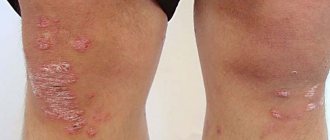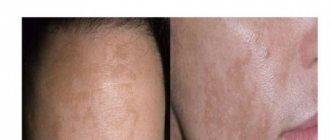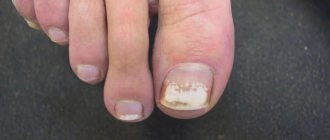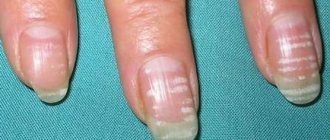The marks may be more noticeable if the soft tissues on the legs are swollen with fluid. This is called peripheral edema.
In most cases, peripheral edema develops because the tissue retains fluid. Often the swelling is mild, goes away on its own and is not associated with any symptoms.
However, sometimes peripheral edema is more severe and may be the cause of the disease. Below are the symptoms, and if sock marks are accompanied by one of them, then there is a reason to consult a doctor.
WHEN PERIPHERAL EDEMA IS MORE SEVERE
If you experience other symptoms of peripheral edema, you may have a serious condition that requires urgent medical attention. Warning symptoms and their possible causes include:
- chest pain: heart failure
- dizziness or fainting: heart failure
- shortness of breath, especially when lying down: heart failure
- swelling in only one leg: deep vein thrombosis (DVT), caused by a blood clot in a vein, or cellulitis
- sudden painful swelling of the lower leg: DVT
- little urine: kidney disease
- abdominal swelling: liver disease
- abdominal pain: swelling
- sudden increase in blood pressure during pregnancy: preeclampsia
More serious is peripheral edema, which is moderate to severe and worsens or does not improve with rest. This should be assessed by a doctor, especially if you have other symptoms or a history of heart, liver or kidney disease.
What are the symptoms of peripheral edema?
Peripheral edema is divided into two types depending on what happens when you press on the swollen area:
- ulcerative swelling, in which marks persist when you stop pressing;
- swelling without pitting, in which the mark immediately disappears after pressing;
Sock marks are more pronounced if you have acute swelling.
Other symptoms of peripheral edema include:
- tight, shiny skin;
- redness;
- fluid oozing from the skin (if severe);
What causes peripheral edema?
Most often, peripheral edema is the result of fluid retention in tissues and is not a disease. This swelling is usually mild and goes away over time.
Dependent edema
When you stand or sit for long periods of time during the day, gravity pulls blood toward your legs. The increased pressure forces fluid from the blood vessel into the soft tissue, causing mild swelling.
Swelling associated with gravity is called dependent edema. This is more pronounced later in the day, which is why sock marks on your feet are more pronounced in the evening. By morning they usually disappear.
Salt
Consuming a lot of salt causes your body to retain water. This results in peripheral edema, which can cause more noticeable sock marks in the evening of the next day.
Hormonal changes
Hormone levels change during a woman's menstrual cycle. This can cause water retention and swelling of the legs in the week before your period.
Pregnancy
As a pregnant woman's uterus expands, it can put pressure on the blood vessels leading to her legs. This slows the movement of blood from her legs to her heart, which can lead to peripheral edema.
Most pregnant women experience peripheral edema, but it can also be a sign of a serious condition called preeclampsia. Other symptoms include the sudden onset of high blood pressure and protein in the urine (proteinuria). In this case, urgent medical attention is required.
Thermal edema
Peripheral edema often occurs in hot weather. Heat causes your blood vessels to open wider, so there is more blood in your legs. If fluid gets into the tissue, swelling develops.
Overweight
Obesity can cause excess fat in the abdomen and pelvis, which can put pressure on blood vessels, slowing blood flow from your legs. It accumulates in the veins, and the increased pressure pushes fluid into the soft tissue.
In such cases, peripheral edema is usually more severe and does not go away without treatment.
Venous insufficiency
One-way valves in your veins prevent blood from flowing into your legs.
These valves can weaken and begin to fail as you age. Blood enters the veins of the legs and leads to peripheral edema. This disease is called venous insufficiency. It can also cause cramps and pain in the legs.
Chronic heart failure
Congestive heart failure occurs because your heart is weak or damaged and cannot pump blood effectively. Blood and fluid return to your legs and sometimes to your lungs (pulmonary edema).
Other symptoms include rapid weight gain and shortness of breath.
Kidney disease
With kidney failure, your body can't remove enough fluid from the body, so it accumulates in your tissues—especially in your legs. Swelling around the eyes (periorbital edema) is not uncommon in such cases.
Liver disease
Diseases such as hepatitis and alcoholism can damage your liver (cirrhosis), making it difficult for blood to pass through the organ.
As a result, blood flows into the lower body and fluid accumulates in the abdomen (ascites) and legs. Yellow eyes and skin (jaundice) may also appear.
Poor nutrition
May lead to low levels of a protein in the blood called albumin.
Albumin helps retain fluid in your blood vessels. Without it, fluid begins to seep into the soft tissue.
Some medications
Medicines that can cause peripheral edema:
- contraception: estrogen-containing birth control pills;
- diabetes mellitus: rosiglitazone (Avandia), pioglitazone (Actos);
- high blood pressure: calcium channel blockers such as amlodipine (Norvasc) and nifedipine (Adalat CC, Afeditab CR and Procardia XL);
- inflammation: nonsteroidal anti-inflammatory drugs (NSAIDs), such as ibuprofen (Advil);
- Parkinson's disease: pramipexole (Mirapex);
- seizures: gabapentin (Neurontin);
Causes
Sock marks can appear on your feet for a variety of reasons, varying in severity.
Water retention
Water retention can cause socks to leave marks on your feet. Swelling that results from water retention is usually benign. This may cause general swelling or puffiness of the arms, legs, or face. Symptoms appear when standing or sitting for long periods of time. This may also occur during menstruation.
Pregnancy
Although some swelling is common during pregnancy, it can sometimes be a sign of preeclampsia. Preeclampsia is a condition that causes high blood pressure during pregnancy and after childbirth. Pregnant women who have swelling should consult a doctor.
Venous insufficiency
This condition may be accompanied by swelling of the feet and ankles. Venous insufficiency means that the veins have difficulty transporting blood from the legs back to the heart. As a result, blood pools in the legs, displacing fluid from the blood vessels into the surrounding tissue. Venous insufficiency is the most common cause of peripheral edema in people over 50 years of age.
Phlebeurysm
Varicose veins are a condition in which the veins become enlarged and are commonly found on the feet and legs. Other symptoms include:
- swelling of the ankle and foot
- burning and throbbing in the legs
- pain and heaviness in the legs
- muscle spasms in the legs, especially during sleep
- dry and itchy skin over the vein
Congestive heart failure
Congestive heart failure is a condition in which the heart cannot pump blood normally throughout the body. As a result, blood flow from the heart slows and blood pools in the veins. This buildup causes fluid to leak into the surrounding tissue, causing swelling. Swelling may affect the legs and abdomen. Other symptoms include:
- shortness of breath
- fatigue
- swelling of the legs and ankles
Kidney diseases
Kidney disease can cause swelling in a person's legs and around the eyes. This swelling occurs because the kidneys cannot effectively remove sodium and water from the body.
Liver diseases
Cirrhosis
is a term for scarring of liver tissue that is caused by various liver diseases. Many people may not know that they have cirrhosis of the liver. The reason for this is that they do not have symptoms until the liver is severely damaged. Those with early symptoms may notice:
- fatigue
- weakness
- low appetite
- unexplained weight loss
- nausea
- vomiting
- mild discomfort or pain in the upper right abdomen
As liver function deteriorates, swelling may occur in the legs, ankles, and feet.
Lung diseases
Lung diseases such as chronic obstructive pulmonary disease (COPD) may cause swelling in the legs and feet. This symptom can develop when the pressure in the lungs and heart becomes very high. This is a less common symptom and may be a sign that COPD has reached an advanced stage.
Lymphedema
Lymphedema is a chronic condition that occurs when the lymphatic system is damaged. Doctors can recognize this condition by the accumulation of lymph fluid in the body. Edema can occur anywhere, but mainly affects:
- legs
- hands
- genitals
- face
- neck
- oral cavity
What to do if only one foot has sock marks?
Peripheral swelling in only one leg is never normal and requires urgent medical attention. Reasons include:
DVT
A blood clot in your leg vein is called deep vein thrombosis, or DVT. It causes sudden pain and swelling, usually in the lower leg area.
Without prompt treatment, the clot can rupture and travel to the lungs. This is called a pulmonary embolism and can be life-threatening.
Cellulite
Infected skin or soft tissue (cellulitis) is usually swollen. Surgery is necessary to prevent the infection from spreading into the bloodstream or bone.
Lymphedema
Lymph is a fluid containing white blood cells. It flows through lymph nodes and special channels throughout the body.
Lymphedema develops when a tumor or other mass pushes through and blocks lymph channels, or when lymph nodes are removed by surgery or damaged by radiation therapy.
When to see a doctor
When socks leave marks on your feet, this may not always be a sign of any serious illness. Sometimes this can occur during prolonged standing, pregnancy, or flying on an airplane. However, persistent or frequent swelling may be a sign of a medical condition. You should talk to your doctor if swelling in your legs, arms, or other parts of your body occurs regularly. It's also important to see a doctor if other symptoms accompany swelling, such as high blood pressure or blurred vision. Your doctor can determine the cause of the swelling and recommend an appropriate treatment plan.
How is peripheral edema diagnosed?
Your medical history and physical examination will give your doctor clues about the cause of leg swelling, but tests are often needed for diagnosis.
The test is selected based on the organ being assessed.
- blood tests that evaluate the function of most organs, including your heart, liver and kidneys, as well as albumin levels;
- a urine test that evaluates kidney function;
- chest x-ray, an imaging test that evaluates your lungs and heart;
- electrocardiogram, another test to evaluate your heart function;
- Ultrasound, an imaging test to help diagnose DVT and abdominal mass (ascites);
- CT scan of the abdomen, an imaging test that helps your doctor check the abdominal mass;
How is peripheral edema treated?
There are several methods you can use to reduce mild peripheral edema. You can also use them in conjunction with treatment for the condition that is causing your swelling.
WAYS TO REDUCE SWELLING
- Reduce salt intake.
- Start losing weight.
- Raise your feet above heart level while sitting or lying down so that gravity pushes fluid out of your legs rather than into them.
- Take frequent breaks and elevate your legs if possible when standing or sitting for long periods of time.
- Wear compression stockings.
- Train your calf muscles. The contractions help push blood through your veins so it can't pool in your leg and leak into the soft tissue.
Diuretics
Diuretics (diuretics) remove excess fluid from the body. They are used only when peripheral edema is caused by a medical condition.
Treatment for specific causes
Treatment may depend on what is causing the peripheral edema. Here are some possible treatment options for specific causes of peripheral edema:
- venous insufficiency: compression stockings, vein stripping (vein removal), or surgical repair;
- congestive heart failure: diuretics or medications that help your heart work more efficiently;
- kidney disease: medications that increase urine production, dialysis or kidney transplant;
- liver disease: antiviral medicine for hepatitis, limiting alcohol, or having a liver transplant;
- poor nutrition: a nutritious diet that contains sufficient protein;
- lymphedema: compression stockings or lymphatic drainage massage;
- DVT: blood thinner;
- cellulite: antibiotics;
Bottom line
Sock marks on feet are caused by the pressure of the elastic band in them. Peripheral edema will make the marks more visible.
Most often, peripheral edema develops when excess fluid in your body is pulled toward your legs by gravity. The swelling is usually mild, temporary and harmless.
However, peripheral edema may be a symptom of a serious medical condition. If this is the case, the swelling becomes more pronounced and persistent, and is usually accompanied by other symptoms.
If your sock marks are more noticeable, take a closer look at your feet. If you notice new, enlarged swelling or ulcers, consult your doctor immediately. You may have a medical condition that requires immediate treatment.
ADDITION
Sock marks are a sign of leg swelling, which can be caused by high blood pressure.
Treatment
If a person has sock marks on their feet due to water retention, then you can try the following:
- lie down or sleep with your legs elevated
- massage your feet, ankles or lower legs
- do light exercises
- avoid wearing tight socks, shoes or clothing
If peripheral edema is the result of a medical condition, the person needs treatment.
Diuretics can treat some conditions that cause edema, such as congestive heart failure, kidney disease, and liver disease. Specific treatments will depend on the condition affecting the person, their age, and their overall health.
Sock marks may indicate high blood pressure
Standing or sitting for too long can cause swelling of the lower leg, the first symptoms of which are tight shoes and marks from socks.
These symptoms are not always an indicator of a serious problem if they are mild and infrequent. Repeated or worsening swelling of the lower leg may be a sign of a chronic health problem.
“Swelling in the ankles is not normal,” said Dr. Michael McGill, a cardiologist at the Marshfield Clinic. “You need to take this seriously, especially if symptoms occur too often. Even if this happens from time to time, you should consult a doctor.”
High blood pressure is the most common cause
Swelling occurs when excess fluid accumulates in the lower legs. Swelling is usually not painful in itself, but if your legs and feet are swollen, shoes and socks may be uncomfortable to wear.
“Sodium retention causes high blood pressure and fluid retention, which is the most common cause of leg swelling,” McGill said.
High blood pressure can be accompanied by diastolic dysfunction, a type of heart failure that makes it difficult for the heart to pump blood throughout the body. The body responds to insufficient blood flow by retaining fluid, which settles in the lowest parts of the body, usually the legs and feet.
Venous insufficiency is another cardiovascular problem that can cause swelling. Venous insufficiency occurs when the veins in the legs do not allow blood to flow back to the heart. When the valves in the veins don't work well, blood can pool in the legs and cause painful swelling. This condition is also known to cause varicose veins.
Kidney and liver problems and certain medications can cause swelling in the lower leg. The doctor must conduct tests to find out what is causing the problem.
Most people do not attach much importance to the appearance of red dots on the body , because at first glance they do not at all worsen the general condition of their body. However, if you think about it, there is probably some pathological reason for their occurrence. And the more there are, the more noticeable they are; in addition, red dots can appear on open areas of the body, which causes even more discomfort.
The most common causes of red dots on the body
Traumatic etiology
Of course, many do not even notice the microtraumas that damage the walls of the capillaries. However, this causes blood to leak directly into the subcutaneous fat layer, resulting in a microhematoma, which may not resolve for a long time and constantly reminds itself of itself in the form of a red dot on the body. Most often, traumatic etiology is the result of improper shaving or hair depilation.
Read: Mole or skin cancer? Are you in doubt the whole way?
Hypovitaminosis
The reason for the appearance of red dots on the body may be an insufficient amount of vitamins, in particular such as: K and C, which leads to fragility of blood vessels in the human body and leads to the same outcomes as with a normal injury.
Hemangioma
As a rule, this is a benign tumor disease, characterized by protrusion of the vessel wall and clearly visible on the skin. This disease occurs more often in newborns, and much less frequently in adults. The diameter of hemangiomas varies greatly, from a few millimeters to several centimeters. When pressed, the red dot disappears for a few seconds and appears again. It is worth noting that hemangioma has a predisposition to growth. The most dangerous is considered to be a hemangioma that grows inward, since it can not only compress organs, but also disrupt their functions. In such cases, treatment is carried out surgically (i.e., it is removed).
Liver diseases
If red dots appear on the body, from which branches of blood vessels extend to the sides (like “stars”), having a diameter of 1 mm to 1 cm, it is recommended to consult a doctor. Especially if, when pressed, they disappear due to the outflow of blood, and then fill back up from the center directly to the periphery, then in this case a visit to the doctor absolutely cannot be postponed! Similar symptoms occur with liver cirrhosis and viral hepatitis. In this case, you need to treat the cause (i.e. the liver), and not the red dots on the body.
Skin problems - Stop panic!
Pancreatic diseases
In chronic pancreatic disease, so-called “red droplets” often appear on the patient’s skin. Most often they are localized on the back, chest, and abdomen in the form of small round red spots. Unlike the “stars” described above, the “red droplets” do not disappear when pressed. Treatment is also etiotropic (i.e., aimed at the cause of the disease).
The cause of red dots on the body can be: antipathies, allergic dermatitis, diabetes mellitus, rheumatic diseases, thrombocytopenic purpura. Therefore, doctors recommend seeking advice and not taking any independent actions!!!
REMEMBER – timely consultation with a doctor will save your life!
Book a consultation by phone in Taganrog
Doctors' visiting hours are from 10.00 to 15.00.
Saturday - from 10.00 to 13.00
License No. LO-61-01-003776
The material was prepared by Natalya KOVALENKO. Website illustrations: © 2014 Thinkstock.











